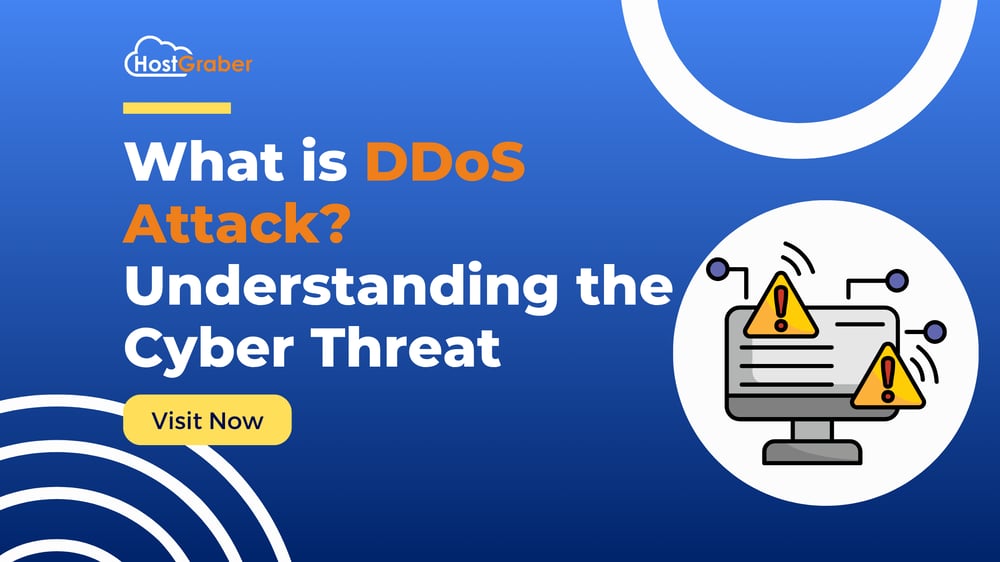What is DDoS Attack? Understanding the Cyber Threat
Web Hosting Tutorial DDOS Attack Jun 30, 2025 5:46:20 PM HostGraber 3 min read

In today’s digital age, cyberattacks have become more sophisticated and damaging than ever. Among the most disruptive is the DDoS attack, a method used by hackers to overwhelm websites, servers, or networks. But what is DDoS attack, and why should you be concerned about it? Let’s break it down in simple terms.
What is DDoS Attack?
DDoS stands for Distributed Denial of Service. A DDoS attack occurs when multiple systems flood the bandwidth or resources of a targeted server, website, or network, causing it to slow down or crash entirely. The primary goal is to make an online service unavailable to its users, either temporarily or permanently.
Unlike a typical Denial of Service (DoS) attack that uses a single source, a DDoS attack uses many compromised devices—often infected with malware—to launch the attack. These devices form what’s known as a “botnet.” Once activated, the botnet sends massive volumes of traffic to the target, overwhelming its systems.
How Does a DDoS Attack Work?
To understand what is DDoS attack, it’s important to know how it operates. The process typically follows these steps:
- Botnet Creation: Cybercriminals infect computers and IoT devices with malware, turning them into “bots.”
- Command and Control: The attacker controls these bots through a centralized system.
- Attack Initiation: All bots are instructed to send requests to the target at the same time.
- Service Disruption: The flood of requests consumes system resources, leading to slowdowns or a complete shutdown.
Common targets include eCommerce websites, banks, government portals, and gaming servers—essentially any service that depends on uptime.
Types of DDoS Attacks
There are several types of DDoS attacks, each targeting different layers of a network. The most common ones include:
1. Volume-Based Attacks
These focus on overwhelming the bandwidth of the target site. They include:
- UDP Floods
- ICMP Floods
- Spoofed Packet Floods
2. Protocol Attacks
These attacks target server resources or intermediate communication devices like firewalls and load balancers.
- SYN Flood
- Ping of Death
- Smurf DDoS
3. Application Layer Attacks
These mimic legitimate user traffic to crash the server.
- HTTP Flood
- Slowloris
- Zero-Day DDoS
Why Are DDoS Attacks Dangerous?
Still wondering what is DDoS attack and why it’s such a big deal? Here are some reasons:
- Business Downtime: A downed website means lost customers, revenue, and trust.
- Data Breach Opportunity: While the security team is distracted, attackers might launch additional attacks to steal data.
- Damage to Reputation: Frequent downtime affects customer confidence and brand image.
- Financial Costs: Recovering from a DDoS attack can be expensive due to system restoration and lost income.
Signs Your Website Is Under a DDoS Attack
- Website or server becomes unusually slow
- Your website is inaccessible for no clear reason
- Increased spam traffic from a single IP or region
- Your hosting provider notifies you of unusual activity
How to Prevent a DDoS Attack
Now that you know what is DDoS attack, let’s look at how to prevent it:
1. Use a CDN or Cloud-Based DDoS Protection
Services like Cloudflare, Akamai, and AWS Shield can absorb and deflect malicious traffic.
2. Set Up Firewalls and Intrusion Detection Systems
A good firewall can detect and block suspicious traffic before it reaches your server.
3. Monitor Traffic in Real-Time
Using monitoring tools can help detect unusual spikes in traffic.
4. Keep Systems Updated
Always update your software, plugins, and systems to patch known vulnerabilities.
5. Have a Response Plan
Ensure your team knows what steps to take in case of an attack, including contacting your hosting provider or security vendor.
Final Thoughts
Understanding what is DDoS attack is the first step in protecting your online presence. Whether you run a personal blog or a large eCommerce platform, no one is immune to these attacks. Investing in proper security measures, staying informed, and having a response plan can save you from major disruptions.
Cyber threats continue to evolve, but with the right preparation, you can keep your website safe and running smoothly. Don’t wait for an attack to happen—act now and safeguard your digital assets.
